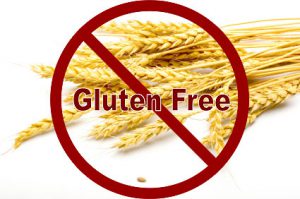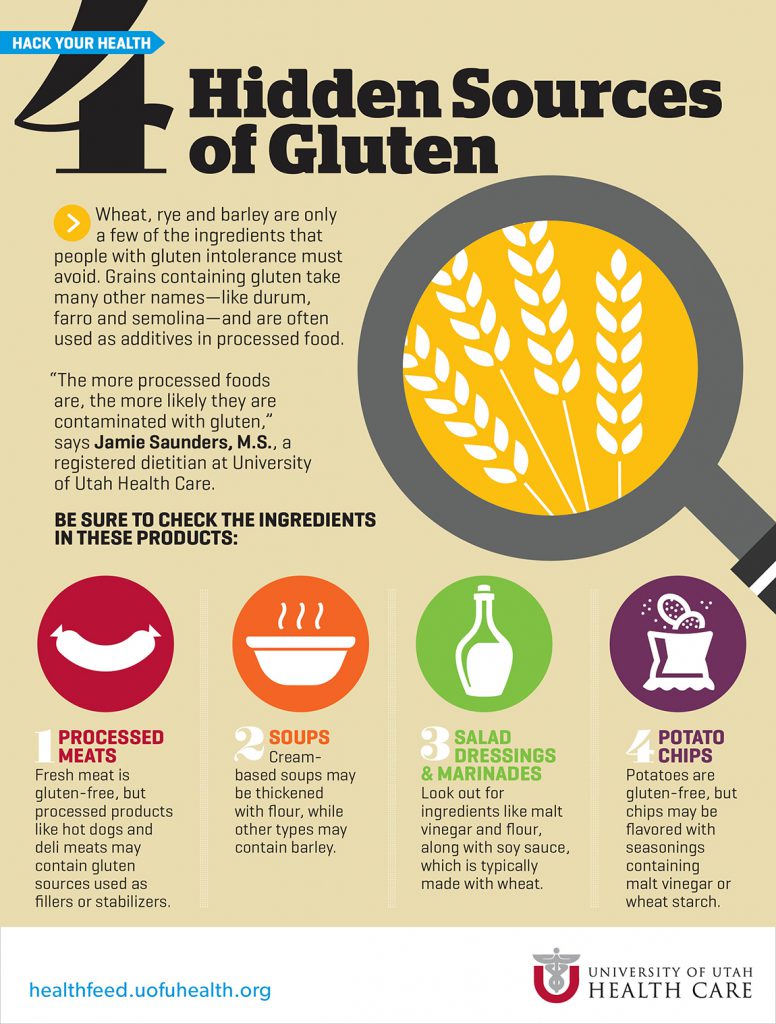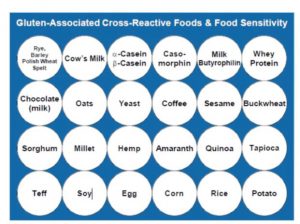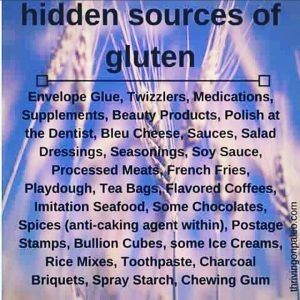Foods That Relieve Gluten Sensitivity
Eat Foods From The Gluten Free Foods List
Print the List For Easy Reference
So, have you been diagnosed with gluten sensitivity or celiac disease and have been instructed to eat only gluten free foods but do not know which foods are gluten free? Do not panic. Our list of gluten free foods will be very helpful. After reviewing the list you will discover eating gluten free will not be so bad after all. Just relax, let your patience and creativity take over. After the adjustment period, you will get into a standard routine and discover eating only gluten free foods is not bad at all.
Does it mean that shopping will take on a different perspective for you and your family? Yes it does. However, with full and complete knowledge, you can make the necessary adjustments and the changes which will allow you to live a long healthy and normal life.
Before We Provide The List, What is Gluten Free?
Just in case you may not know, gluten is a protein. Gluten is found in grains such as wheat, barley, rye, and a cross between wheat and rye called triticale. To avoid sensitivity, these grains must be totally avoided in the foods being consumed. It also means getting familiar with the product label and the ingredients printed on the package.
Who Can Benefit From the Gluten Free Foods List?
Gluten free foods are primarily used to treat celiac disease. Gluten causes inflammation in the small intestines of people with celiac disease. Eating a gluten free diet helps people with celiac disease control their signs and autoimmune symptoms and prevent complications.
Gluten free foods are also recommended for people who don’t have celiac disease but have symptoms. These individuals are known to have non-celiac gluten sensitivity.
How To Use The Lists
Below are seven lists to help those who are on a gluten free diet or have allergic sensitivity to gluten.
The Naturally Gluten-Free Foods List includes foods that can be eaten by celiac diseased and gluten sensitive individuals. Be sure to eat plenty of these foods to ensure adequate vitamins, minerals, and fiber daily.
The Naturally Gluten-Free Foods List containing foods processed or mixed with gluten-containing grains, additives or preservatives must be avoided by those with celiac disease and will need to be avoided by those who have sensitivities when eating gluten.
The Other Gluten Choices will provide additional nutrition and variety. These foods provide variety and should not cause sensitivity or allergies.
The Hidden Gluten-Free Foods List contains foods and products you not expect to find gluten in. Those with celiac disease and sensitivity or allergies should avoid these foods.
The Cross Reactor List contains foods that can become cross reactors to persons on a gluten free diet. Please note that not all of the foods included will be a cross reactor for each person; therefore when consumed watch for symptoms of allergic reaction.
The Avoid Unless Labeled Gluten-Free Foods List will probably contain gluten therefore unless the label indicates the product is gluten free, assume it is NOT.
The Avoid List contains gluten and must be avoided by those with celiac disease and will cause sensitivity and allergies for those with gluten-intolerance.
Print these lists for easy viewing when you plan, buy food and make meals. Once you become familiar with the contents of the lists, your task of selecting only gluten-free food will become much easier and less time consuming.
Naturally Gluten Free Foods List
Below is a list of the gluten free foods that you should consume in the meals you eat every day.
Many healthy and delicious foods are naturally gluten-free and these foods are:
- Beans, seeds and nuts in their natural, unprocessed form
- Fresh eggs
- Fresh meats, fish and poultry (not breaded, batter-coated or marinated)
- Fruits and vegetables
- Most dairy products
Note: If you are allergic to nuts, then skip them in your diet.
Naturally Gluten Free But Avoid If Processed or Mixed With Gluten List
If gluten free foods are processed or mixed with gluten-containing grains, additives or preservatives; they become foods to avoid. Many grains and starches can be part of a gluten free diet, such as:
- Amaranth
- Arrowroot
- Buckwheat
- Corn and cornmeal
- Flax
- Gluten-free flours (rice, soy, corn, potato, bean)
- Hominy (corn)
- Millet
- Quinoa
- Rice
- Sorghum
- Soy
- Tapioca
- Teff
Back to Gluten-foods list.
Other Gluten Free Choices
- Fats – extra virgin olive oil, sesame oil, coconut oil, grass-fed tallow and organic or pasture-fed butter, ghee, almond milk, avocados, coconuts, olives, nuts and nut butters, cheese (except for blue cheeses), and seeds (flaxseed, sunflower seeds, pumpkin seeds, sesame seeds, chia seeds).
- Protein – whole eggs; wild fish (salmon, black cod, mahi mahi, grouper,herring, trout, sardines); shellfish and molluscs (shrimp, crab, lobster, mussels, clams, oysters); grass-fed meat, fowl, poultry, and pork (beef, lamb, liver, bison, chicken, turkey, duck, ostrich, veal); wild game. Note: Skip the dairy items if you are a vegan.
- Vegetables – leafy greens and lettuces, collards, spinach, broccoli, kale, chard, cabbage, onions, mushrooms, cauliflower, Brussels sprouts, sauerkraut, artichoke, alfalfa sprouts, green beans, celery, bok choy, radishes, watercress, turnip, asparagus, garlic, leek, fennel, shallots, scallions, ginger, jicama, parsley, water chestnuts.
- Low Sugar Fruit – avocado, bell peppers, cucumber, tomato, zucchini, squash, pumpkin, eggplant, lemons, limes.
Hidden Gluten Products List
You may not be aware that there are sources of hidden gluten in some of the products you normally use. Below is a list of these products. Always read the labels carefully before using any of them. If it’s not clear that the product is gluten-free, contact the manufacture on the package before purchasing.
Sources of hidden gluten include:
- Dressings
- Envelops
- Food additives, such as malt flavoring, modified food starch and others
- Hairspray
- Lipstick
- Lotions
- Lunch Meat
- Make-up
- Maltodextrin
- Medications and vitamins that use gluten as a binding agent
- MSG
- Pet Food
- Shampoos
- Soups
- Stamps
- Toothpaste
Back to Gluten-foods list.
Cross Reactor Foods
This list of foods will not be complete unless we included a list of foods that can become cross reactors to persons on a gluten free diet. Please note that not all of the foods listed below may be a cross reactor for you. This will vary from person to person. You can try consuming them and if you should notice a reaction, then avoid that food.
List of foods that are cross reactors for persons on a gluten free diet include:
- Amaranth
- Buckwheat
- Chocolate
- Coffee (Instant – Regular fresh ground coffee is okay)
- *Corn
- *Dairy products such as milk and cheese (Alpha-Casein, Beta-Casein, Casomorphin, Butyrophilin, Whey Protein)
- Egg
- Hemp
- *Millet
- *Oats
- Polish wheat
- Potato
- *Rice
- Sesame
- Sorghum
- *Soy
- Tapioca
- Teff
- *Yeast
*Products indicated with an asterisk above are foods that can become cross reactors in most persons with celiac disease or have gluten sensitivity. These products should not be eaten.
If you determine that there are foods that are cross-reactive for you, the treatment is to permanently remove these foods from your diet along with gluten. Remember, that though the cross-reactive foods do not actually contain gluten your body thinks they do and therefore the inflammation and damage to your body is equal to that of gluten.
If you are gluten-intolerant and you are still having health issues even after removing gluten from your diet, try eliminating the foods above for at least two months and see if your symptoms improve.
Then add a food one at a time to determine which one or ones are the cause of your gluten inflammation.
Back to Gluten-free foods list.
Avoid Unless Labeled Gluten Free
In general, avoid the following foods unless they’re clearly labeled as gluten free or made with corn, rice, soy or other gluten free type grain:
- Beer
- Breads
- Cakes and pies
- Candies
- Cereals
- Communion wafers
- Cookies and crackers
- Croutons
- French fries
- Gravies
- Imitation meat or seafood
- Matzo
- Pastas
- Processed luncheon meats
- Salad dressings
- Sauces, including soy sauce
- Seasoned rice mixes
- Seasoned snack foods, such as potato and tortilla chips
- Self-basting poultry
- Soups and soup bases
- Vegetables in sauce
Certain grains, such as oats, can be contaminated with wheat during growing and processing stages of production. For this reason, doctors and dietitians generally recommend avoiding oats unless they are specifically labeled gluten free.
Always Avoid
Avoid all food and drinks that contain:
- Barley (malt, malt flavoring and malt vinegar are usually made from barley)
- Rye
- Triticale (a cross between wheat and rye)
- Wheat
Avoiding wheat can be challenging because wheat products go by numerous names. Consider the many types of wheat flour on supermarket shelves — bromated, enriched, phosphated, plain and self-rising. Here are other wheat products to avoid:
- Durum flour
- Farina
- Graham flour
- Kamut
- Semolina
- Spelt
Back to Gluten-free foods list.
Conclusion
As you can see, this is a lot of information to digest. But, it is important for you to know how to deal with your situation. Knowing the foods you can enjoy along with those you need to avoid should be very helpful. This will allow you to live your life without experiencing any gluten attacks in the future.
You too can feel better and enjoy life more by having sufficient information by which to make decisions regarding your health and what you eat.
Happy Gluten Free Eating!
Go back to the Gluten Free Diet With Nutrition home page.



